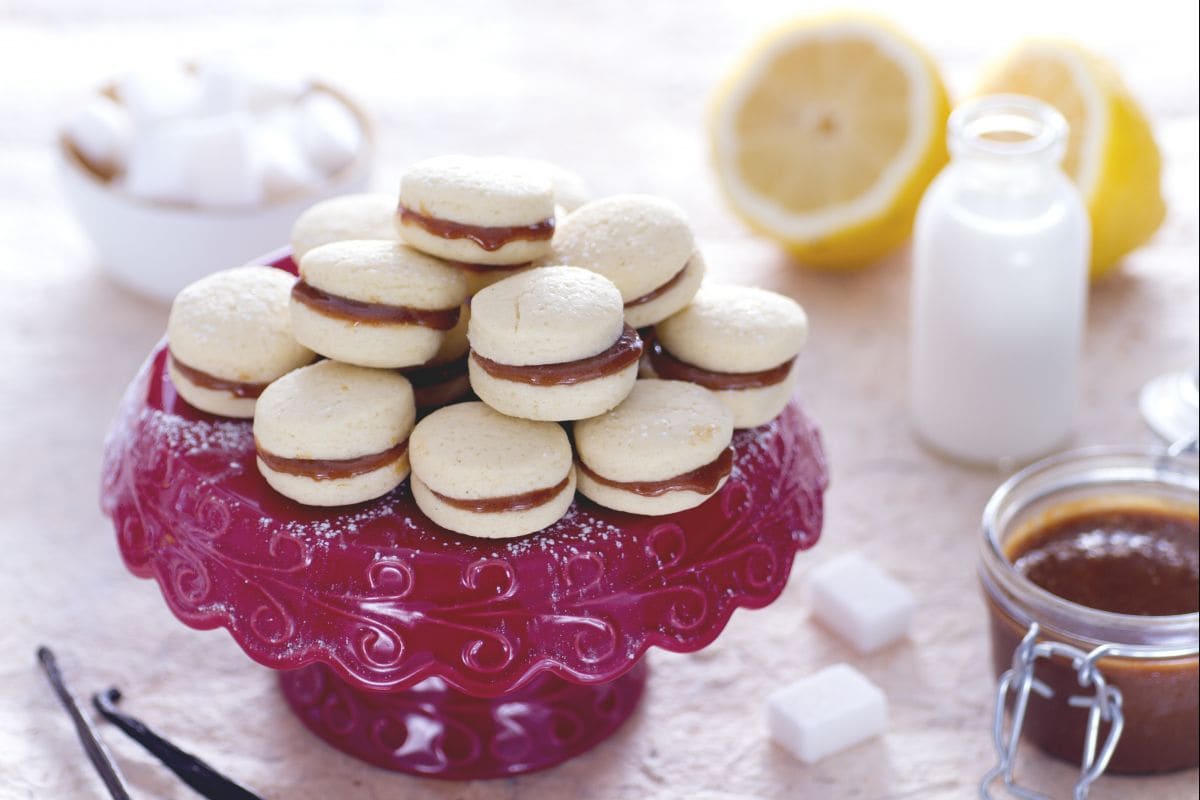Alfajores

- Vegetarian
- Energy Kcal 126
- Carbohydrates g 18.3
- of which sugars g 8.2
- Protein g 1.6
- Fats g 5.1
- of which saturated fat g 2.87
- Fiber g 0.2
- Cholesterol mg 33
- Sodium mg 12
- Difficulty: Easy
- Prep time: 20 min
- Cook time: 1 h 10 min
- Makes: 25 pieces
- Cost: Low
- Note + the dough resting in the refrigerator
PRESENTATION
If you're looking for a treat that really captures the heart of South America, you can't go wrong with alfajores. Seriously good stuff. These dulce de leche cookies are favorites from Uruguay to Argentina, offering a taste that's both nostalgic and delicious.
Imagine two soft, tender cookies made with a blend of flour and maizena or potato starch, hugging a creamy layer of dulce de leche—you'll love it. This gives the cookies their melt-in-your-mouth quality, and people really really come back for more. Some folks go for a jam filling, but the caramel-like center? It's the real star.
In places like Buenos Aires and Montevideo, you’ll often find them rolled in coconut flakes, adding a soft contrast to the moist interior. These cookies are staples at family gatherings and coffee shops—pretty much everywhere—with mate, the traditional herbal tea of the region.
So here's the thing, what makes alfajores so special is their variety. Each town and family has their twist—like, a dusting of powdered sugar or a thicker filling. Some like them big and soft, others enjoy smaller, crispy ones. No matter the style, biting into these South American sandwich cookies is an experience in itself.
The golden exterior crumbles to reveal a sweet center. Perfect for an afternoon snack, especially with mate, as the drink enhances the tangy and creamy flavors of the cookies. You can find these really good Latin American sweets in a bustling bakery or a cozy family kitchen. Each offers its own unique take. And look, whether you’re sticking to the classic or exploring regional variations, alfajores are a comforting slice of South American life. With every bite, you’re reminded of the warmth and hospitality that's at the heart of this South American dessert. It's impossible not to come back for more.
You might also like:
INGREDIENTS
- Ingredients for about 25 alfajores
- Potato starch 1 ¼ cup (150 g)
- Type 00 flour 1 ¼ cup (150 g)
- Sugar 0.4 cup (75 g)
- Butter 4.5 oz (125 g) - (softened at room temperature)
- Baking soda 1 pinch
- Lemon peel 1
- Eggs 1
- Egg yolks 1
- For the dulce de leche
- Sugar ½ cup (100 g)
- Vanilla bean ½
- Milk 1.4 cups (330 ml)
- Baking soda 1 pinch
How to prepare Alfajores

To prepare the alfajores, start with the cookie dough: in the bowl of a stand mixer, add the sugar and soft butter in pieces 1, start the whisk and meanwhile separate the yolk from the white 2. Add the yolk to the dough 3

and when it is incorporated, add the whole egg 4 and let it incorporate. In a bowl, sift the flour, potato starch (or cornstarch), and grate the lemon zest 5. Then stop the mixer, add the powders to the mixture 6

mix everything with a spatula 7, then attach the paddle attachment and work the dough for a few more minutes until it is homogeneous 8: the dough will be very soft. Then transfer it onto a sheet of plastic wrap 9

wrap it carefully to form a block (10-11) and let it rest in the refrigerator for at least 2 hours. Meanwhile, work on the Dulce de leche: in a saucepan, pour the milk and the split vanilla bean 12 (you can also use half for a less intense aroma);

add the sugar and baking soda 13, heat over low heat and stir with a wooden spoon 14. Continue cooking until the milk reaches a boil, then keep stirring until the obtained cream darkens. At this point, remove the vanilla bean with kitchen tongs 15

and continue cooking the dulce de leche over medium heat until you achieve a gooey consistency similar to caramel sauce (this will take about 1 hour) 16. Keep in mind that the longer you cook it, the harder the dulce de leche will get. Once ready, put it in a small bowl and let it cool to room temperature. After the necessary time, take the dough, sprinkle it with a little flour, and roll it out 17 to a thickness of half a centimeter (0.2 inches). Use a 4 cm (1.5 inches) diameter cookie cutter to make the discs 18

that you can place on a baking sheet lined with parchment paper 19: to keep their shape well, it is advisable to put them back in the fridge for about ten minutes. Then bake them in a preheated static oven at 356°F (180°C) for about 10 minutes (320°F/160°C for 5 minutes if using a convection oven); for better baking, you can try baking 1-2 alfajores as a first batch to test times and temperature. Once cooked, take them out and let them cool on a rack; when both preparations are well chilled, you can assemble the alfajores: Spread the dulce de leche on half of the cookies and close with the other disks (20-21). Serve the alfajores at any time of the day!